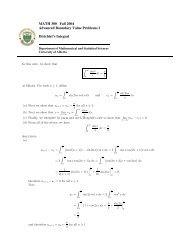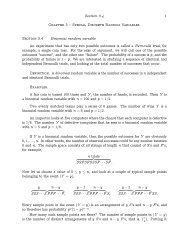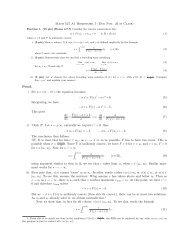Math 411: Honours Complex Variables - University of Alberta
Math 411: Honours Complex Variables - University of Alberta
Math 411: Honours Complex Variables - University of Alberta
Create successful ePaper yourself
Turn your PDF publications into a flip-book with our unique Google optimized e-Paper software.
Pro<strong>of</strong>. (i) =⇒ (ii) is Corollary 11.2.2, (ii) =⇒ (iii) is shown in the pro<strong>of</strong> <strong>of</strong> Corollary<br />
11.2.3, (iii) =⇒ (iv) is trivial, (iv) =⇒ (v) follows from Theorem 17.3, and (v)<br />
=⇒ (i) is implied by Proposition 17.1.<br />
(i) ⇐⇒ (vi) is Corollary 11.2.1 and (vi) ⇐⇒ (vii) follows from Theorem 4.1.<br />
(i) =⇒ (viii) follows from Theorem 11.1, and (viii) =⇒ (vii) is established in the<br />
pro<strong>of</strong> <strong>of</strong> Theorem 11.2.<br />
(v) =⇒ (ix): Let u: D → R be harmonic. If D = C, the existence <strong>of</strong> a harmonic<br />
conjugate is immediate by Theorem 14.1. So suppose that D �= C. Hence, there is a<br />
biholomorphic map f: D → D. It is easily seen that ũ := u◦f −1 : D → R is harmonic<br />
and by Theorem 14.1 has a harmonic conjugate ˜v: D → R. Then v := ˜v ◦f: D → R<br />
is a harmonic conjugate <strong>of</strong> u.<br />
(ix) =⇒(ii): Letf: D → C beholomorphicsuch thatZ(f) = ∅. Thenu := log|f|<br />
is harmonic and thus has a harmonic conjugate v : D → R so that g := u + iv is<br />
holomorphic. On D we have<br />
so that<br />
|expg|= |exp(u+iv)|= expu = |f|,<br />
D → C, z ↦→ f(z)<br />
exp(g(z))<br />
is a holomorphic function whose range lies on ∂D and therefore isn’t open. By the<br />
Open Mapping Theorem, this means that there exists c ∈ ∂D such that f(z) =<br />
cexp(g(z)) for z ∈ D. Choose θ ∈ R with exp(iθ) = c, and note that f(z) =<br />
exp(g(z)+iθ) for z ∈ D.<br />
Definition. Two (not necessarily piecewise smooth) closed curves γ1,γ2: [0,1] → D<br />
with γ1(0) = γ2(0) andγ1(1) = γ2(1) arecalled path homotopicifthere is acontinuous<br />
function Γ: [0,1]×[0,1] → D such that,<br />
for t ∈ [0,1] and<br />
for all s ∈ [0,1].<br />
Γ(0,t) = γ1(t) and Γ(1,t) = γ2(t)<br />
Γ(s,0) = γ1(0) and Γ(s,1) = γ1(1)<br />
Definition. A closed curve γ is called homotopic to zero if γ and the constant curve<br />
γ(0) are path homotopic.<br />
Further Characterizations <strong>of</strong> Simply Connected Domains. There are further<br />
conditions that characterize simply connected domains. We will only state them,<br />
without giving pro<strong>of</strong>s. Simple connectedness is also equivalent to:<br />
(x) every (not necessarily smooth) curve in D is homotopic to zero;<br />
(xi) D is homeomorphic to D.<br />
117







